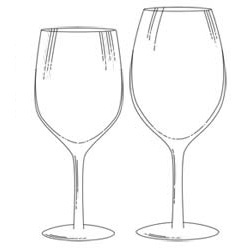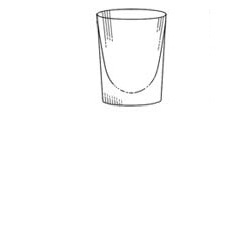A cocktail’s appeal does not rest entirely on its taste. Dump a few fingers of Pappy Van Winkle into a Solo cup and sure enough, it’s still Pappy – but you are missing out on an important visual element. Whether it’s the delicate amber of a fine bourbon or the jewel tones of some ghastly mutant “martini,” how our drinks are prepared and presented affects our enjoyment of them. The best aid to both correct preparation and stylish presentation (besides constant, daily practice) is the right glass.
Owning proper glassware is an absolute must, whether you have a regular happy hour or you only enjoy the occasional evening tipple. As you become more established, a matching set makes a better impression than a hodgepodge assortment.
Below I’ve outlined the pieces that I believe are essential for the at-home drinker to own, followed by a few that are less essential but still nice to have. This is by no means an exhaustive list; it is simply meant as a starting point.
You can go very far with just the basics, so it makes sense to begin your collection with these.
 |
Mixing Glass: A well-kept bar will often include a glass pitcher for those times when shaking will not do. You can always use the glass from your Boston shaker, but a stylish mixing glass will elevate your collection and impress your guests. These can be large, as with a martini pitcher, or more compact like this model. The molded spout is useful for pouring, as it will help prevent ice from plopping into your concoction and splashing your hard work all over a guest. I prefer the smaller version as it accommodates a Hawthorne strainer, thus removing all fear of rogue cubes. |
 |
Old-Fashioned glass: The Old-Fashioned glass is a straight-sided, thick-bottomed tumbler, between 4 and 8 ounces in capacity. It’s short, sturdy design is ideal for drinks poured over ice, or whiskey taken neat. It is also known as a rocks or whiskey glass, and can be ornately designed or plain. The extra thickness of the base allows for muddling of fruit or other ingredients. Larger versions are known as double-rocks or double Old-Fashioned glasses. Suggested: Old-Fashioned; Gin & Tonic; Sazerac |
 |
Highball glass: The Highball glass is taller than the rocks glass, while retaining it’s straight sides. Holding 8-12 ounces, it is used for (oddly enough) highballs – a base spirit plus a larger amount of non-alcoholic mixer, like cola. It’s useful for many other long drinks. This glass should definitely occupy space on your shelf, as it will see a lot of use. Suggested: Cuba Libre; Screwdriver; Cape Codder |
 |
Cocktail glass: The classic cocktail glass is an absolute must for the home bar. Nothing better displays a shaken or stirred cocktail. The stem allows the drinker to avoid warming the beverage, which can alter its taste and smell. They vary widely in size, and some are comically large. You may have to adjust your drink recipes to account for extra volume. The cocktail glass and the martini glass are slightly different, with the former having a slightly more rounded bowl, but in practice either of the two may be used when a cocktail glass is called for. Suggested: Martini; Manhattan; Brandy Alexander |
 |
Champagne flute: Not just for sparkling wine alone, these are an elegant essential for crafting the various champagne cocktails – some of which can actually pack a wallop.They hold 6-9 ounces. The tall, stemmed glass has a narrow opening that both captures the aroma of the beverage and helps keep the bubbly… well, bubbly.
Suggested: French 75; Bellini; Death in the Afternoon |
 |
Wine glasses: Wine glasses will serve you well whether you are partaking of the grape or making mixed drinks. Both have narrow openings for capturing the nose of the wine and tall sides for swirling it. The red wine glass is generally wider, which allows the wine to breathe. The white wine glass is narrower, the better to keep the white chilled.
Suggested: Piña Colada; Frozen Margarita; Kentucky Stinger |
 |
Shot glass: These are ostensibly for measuring purposes, but sometimes it’s just that kind of night…or morning (no judgment here). You doubtless already have one or two clinking around that you received as a promotion or picked up at a tourist trap. If shooters are your thing, you’ll want to upgrade to a stylish set.
Suggested: Shot of whiskey; Shot of tequila; Boilermaker |
 |
Collins glass: Similar to a highball glass, and often interchangeable, the Collins is slimmer and taller. Through complicated physics I do not pretend to understand, this shape keeps the drink colder and more carbonated. It holds 10-14 ounces and is perfect for iced or fizzy drinks. Extra-large versions of both collins and highball glasses exist and are known as chimneys. Suggested: Mojito; Tom Collins; Mai Tai |
 |
Coupe glass: The legend goes that the champagne coupe was first molded from the breast of Marie Antoinette, but that’s highly dubious. What isn’t in question is that the elegant lines of this classic cocktail glass add a refined touch to many of the signature cocktails. However, it should not be used for actual champagne as the bowl’s shape allows the wine to quickly lose its effervescence. Suggested: Manhattan; Fourth Regiment; Lillet & gin |
 |
Cordial glass: Small, stemmed cordial glasses are used for aperitifs, digestifs, and dessert liqueurs. They typically hold anywhere from 1 to 4 ounces. Breaking these out in the course of a dinner party will mark you as a host with a certain measure of refinement and taste. Suggested: Limoncello; Pousse-cafes; Port |
 |
Irish coffee glass: Most alcoholic drinks are chilled, but sometimes the comfort you need can only be found in a glass of something hot. The Irish coffee mug is heat-resistant glass, and can be one solid piece or placed in an attractive metal base. They are just the thing to showcase a hot chocolate topped with whipped cream, or something with a little more oomph. Suggested: Irish coffee; Mulled wine; Hot Toddy |
 |
Glencairn whisky glass: It is not strictly necessary to add this glass to your collection, but if you are a connoisseur of whisky you would be well-served to do so. The shape of the glass collects the nose of a good scotch, making it that much easier to appreciate. The master distillers use it to taste their product, and you would benefit from their example. Only fill it with about an ounce and a half. Suggested: Your favorite scotch whisky |
 |
Brandy snifter: The snifter is used for drinking brandy and whiskey, often (but not always) while dressed in a smoking jacket and brooding in front of a fireplace. Held in a warming hand, the wide bowl allows the liquor to evaporate while the narrow opening traps the aromas. To make sure you have just the right amount in the glass, lay it on its side and add the spirit until it very nearly spills out. These take a bit of practice to drink from, so in the early days you may experience a certain amount of dribbling onto your shirt. Persevere! Suggested: Dumante Verdenoce; Cognac |
One final note: It’s important to remember that it’s not enough to simply own the glassware and toss it in a cabinet. You must keep it clean – free of dust and assorted schmutz. There are few sights so handsome in a home bar as a tidy shelf of gleaming glassware, and few so disappointing as unlooked-for flotsam in an otherwise artfully prepared beverage.
Follow Neal Dewing on Twitter.









